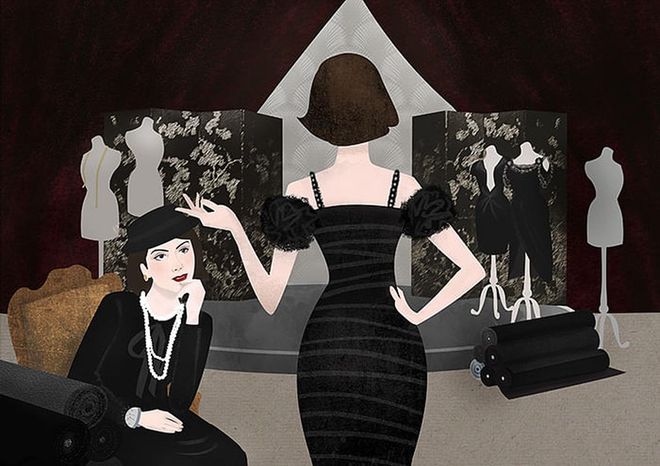Chanel Short Stories: LBD
For the second installment of our exclusive series of short stories with award-winning author Amanda Lee Koe, she takes on one of Coco Chanel's enduring symbols of style


Illustrated by 160 Works; Animated by Charlotte Yap
chanel short stories
In the second part of our exclusive short story series with award-winning writer Amanda Lee Koe, we shine the spotlight one of Gabrielle Chanel's epoch-defining creations: the Little Black Dress.
"Women think of all colours except the absence of colour," the legendary designer once quipped. "I have said that black has it all. White too. Their beauty is absolute. It is the perfect harmony."
It was an unconventional choice of colour in the 1920s, when it was the reserve of widows and servants, but Chanel turned it on its head by using it in her designs and canonizing it as the chicest colour anyone could wear. With this in mind, Koe takes us on a journey that reimagines the designer's fearless choice that would usher in a new chapter in fashion history.
Inspired by the trailblazing spirit of Gabrielle Chanel, Harper’s BAZAAR Singapore has collaborated exclusively with award-winning writer Amanda Lee Koe on a six-part short story series exploring key themes in the fashion icon’s life: her style, her daring, her loves, her friendships, her beauty and her obsession with the mystical. Catch up with all our short stories here.

Illustration by 160 Works
chanel short stories
THE OPPOSITE OF LUXURY IS NOT POVERTY,
you said,
IT IS VULGARITY.
|
Women have thought of every colour—other than the absence of colour.
|
Why women would want to wear frilled tents on their bodies and huge loaves on their heads, gilded with blooms and fruits and plumes, as if to invite men to nest in their skirts and birds to roost in their hair, you could not say. When you had it your way, silhouettes would be simple. Rather than weighing her down or restricting her movement, materials would free a woman to move her body. If it were up to you, one day, every woman in Paris would be in a little black dress.
|
|
It would look like everyone was in mourning, your embroiderer said.
|
Your embroiderer was the sister of one of your lovers, a grand duke Russian émigré. Their nobility torn to shreds, they were remaking themselves in Paris. You gave her a job. With a gaggle of babushkas, she embroidered patterns you commissioned on your couture designs. She wore her hair long, in a big bun. You tried to close an eye to it, but one day you snatched up a sewing scissors and pointed them at her. In shock she turned to you. Gabrielle, she said, what is the matter? I cannot see you any longer with that unattractive bun, you said, it will have to come off. You bent over, removing her hairpins deftly, and began snipping.
|
YES,
you said,
THEY WOULD BE MOURNING THE DEATH OF BAD TASTE.
|
Your embroiderer never wore her hair long again.
|
|
It was wrong to think that dressing in black eliminated all originality in women. In a confident woman, dressing in black revealed her true individuality. When a woman dressed in colour, she drew attention to her dress. When a woman dressed in black, she drew attention as much to herself as to her dress.
|
Nothing was more difficult to make than a little black dress. Eschewing frou-frou ornamentation, it lived or died on its own dime: economy of line.
|
When you drafted a dress you did not do it on a drafting table on paper in pencil the way the men did; you did it on a woman’s body with your own hands, so you could see just how the fabric fell. Silk, crepe, chiffon, wool, jersey—it did not quite matter what the material was, or how much it had cost—it was the weight you turned over as you pinned it to a model who had stood in your atelier for seven hours straight, as you tucked and cut around her body in silence but for the rustle of thin metal as the fitter handed you pins from an enamel scene box.
|
You took undyed jersey, used only for men’s underwear, and turned it into the must-have of the season. The liking for jersey has developed into a passion, the magazines wrote, a veritable craze. You took rabbit, the cheapest of furs, and attached it to your designs. The richest and chicest flocked to Maison Chanel to purchase them. You took black, hitherto the colour of uniformed servants and grieving relatives, and in your hands the magazines predicted: Mlle Chanel’s little black dress will become a sort of uniform for all modern women of taste.
|
|
SHE DOESN’T CONCERN HERSELF WITH FASHION,
the magazines wrote,
BUT WITH HER FASHION.
|
What you always told yourself: in order to be irreplaceable, one has to be different.
|
THE MORE LAVISH A DRESS IS,
you knew,
THE POORER IT BECOMES.